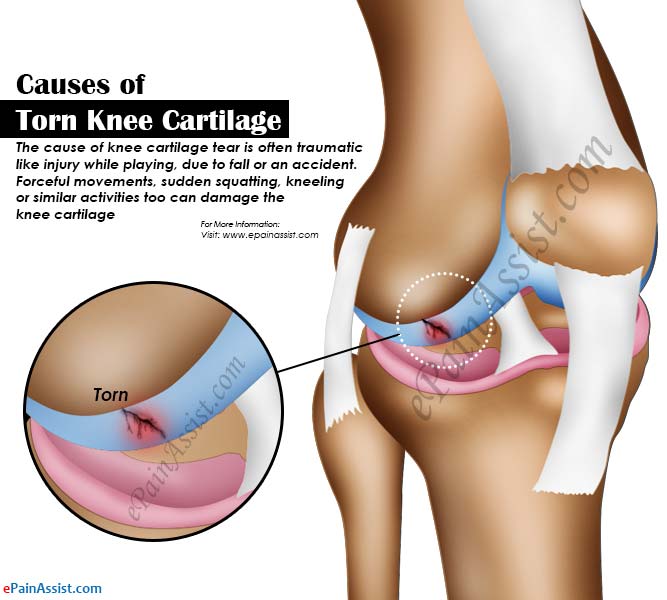Knee cartilage is known to absorb shock, support the knee joint and prevent pain or injury to the knee joint. The knee cartilage is a C-shaped structure placed in between the knee joint. These shock absorber cartilage tissue are called menisci and the one covering at the ends of the bone is the articular cartilage.

Torn knee cartilage or damage to the knee cartilage is commonly seen in sports injuries. A tear in the knee cartilage can cause significant pain and discomfort in the knee joint.
Causes of Torn Knee Cartilage
Torn knee cartilage is often a result of sudden, twisting, forceful movements of the knee joint. The cause of knee cartilage tear is often traumatic like injury while playing, due to fall or an accident. Forceful movements, sudden squatting, kneeling or similar activities too can damage the knee cartilage.
Sports injuries are the commonest cause of knee cartilage damage or meniscus tear. Those with a history of knee injury or a previously torn knee cartilage may be slightly at an increased risk for further cartilage damage. Certain sports that involve pivoting the knee and forceful jerking knee movements are at greater risk for the tear of knee cartilage.
Sometimes, repeated stress and strain on the knee joint can lead to damage or tear of the cartilage in certain areas. Osteoarthritis, a common degenerative joint condition, results from wear and tear of the knee joint. Older adults, those with previously injured or operated knee joint and overweight people are more likely to have torn knee cartilage.

Some other bone and joint conditions too can affect the knee cartilage or make the knee meniscus weak like certain infections affecting the joint or disorders of joint formation.[1]
Symptoms of Torn Knee Cartilage
Although the knee cartilage does not have blood or nerve supply, pain is often felt in the surrounding areas of the knee joint. The torn knee cartilage sets an inflammatory reaction and the joint lining get irritated.
Torn Knee Cartilage causes pain, swelling in the joint and difficulty in moving the joint. It may be particularly difficult to bear weight on the knee joint, stand or walk. Bending or straightening the knees may be painful and the swelling often restricts these movements.
Sometimes, a torn knee cartilage makes it difficult to perform regular activities and a locking sensation is felt in the knee joint. This is because, the torn cartilage interferes with the joint movement making any knee movement difficult and painful.
In case of traumatic knee cartilage injury, a history of sudden twisting and forceful movement is present. Additionally, the person may feel a popping sensation in the knee on doing such a movement, followed by knee pain, swelling and inability to move the knee.
Knee cartilage tears occurring due to wear and tear, are usually noticed when the joint aches and swells in reaction to the torn cartilage. Difficulty in walking and painful joint movements may be felt over a period of time due to torn knee cartilage.[2]
Diagnosis of Torn Knee Cartilage
Diagnosis of torn knee cartilage is based on the history of the person, background and the activities that were being performed in recent past. In case of injuries, X-rays may be taken to rule out any trauma to the bone or any other abnormality, but these do not help to identify a torn knee cartilage. MRI is required to detect bone and soft tissue injuries like cartilage or meniscal tears.
Treatment of Torn Knee Cartilage
Treatment broadly depends on the cause of the knee cartilage tear, however, as the cartilage does not have blood supply, it takes time to heal.
Acute injury is managed with rest, ice packs, compression and elevation of the knee. Inflammation, swelling and knee pain needs to be managed with pain-killers, anti-inflammatories and rest. For minor tear of knee cartilage, immediate medical care, rest and immobilization can be helpful.
For pain associated with torn knee cartilage that does not resolve, an arthroscopic examination and treatment is often done to detect the exact nature of injuries and any associated ligament injuries. Surgical treatment for torn knee cartilage can be done based on the nature and severity of injury or cartilage damage. Newer techniques that promote regeneration or implantation of a new cartilage in place of the torn knee cartilage are being introduced.
Physical therapy that includes physical modalities like heat, ultrasound, etc. may be helpful to deal with torn knee cartilage. As time passes and the acute phase of inflammation, swelling and pain associated with torn knee cartilage subsides, knee strengthening exercises are usually recommended. For example:
- Sit on a chair and raise the knee to straighten the leg, hold and release.
- Stand and bend the knee backwards, trying to touch the buttocks, hold and release.[3]
Recovery Period for Torn Knee Cartilage
As the torn knee cartilage is an avascular structure, the healing is difficult and takes more time. Knee injuries, most commonly are cartilage tears or meniscal tears. In case of minor tears of knee cartilage that need rest, healing period will be about six to eight weeks.
For torn knee cartilage, requiring surgical repairs for partial removal, complete rest and immobilization is required for at least 2 weeks after surgery. This is followed by rehabilitation with limited motion for the next 2 weeks. With a successful rehabilitation, the next 2 weeks can be devoted to slowly resuming normal activities, however, heavy stress on knee joint, squatting and sports activities may have to be avoided for few months. With good rehabilitation and regular physical therapy exercises for a torn knee cartilage, good recovery can be expected.[4]
